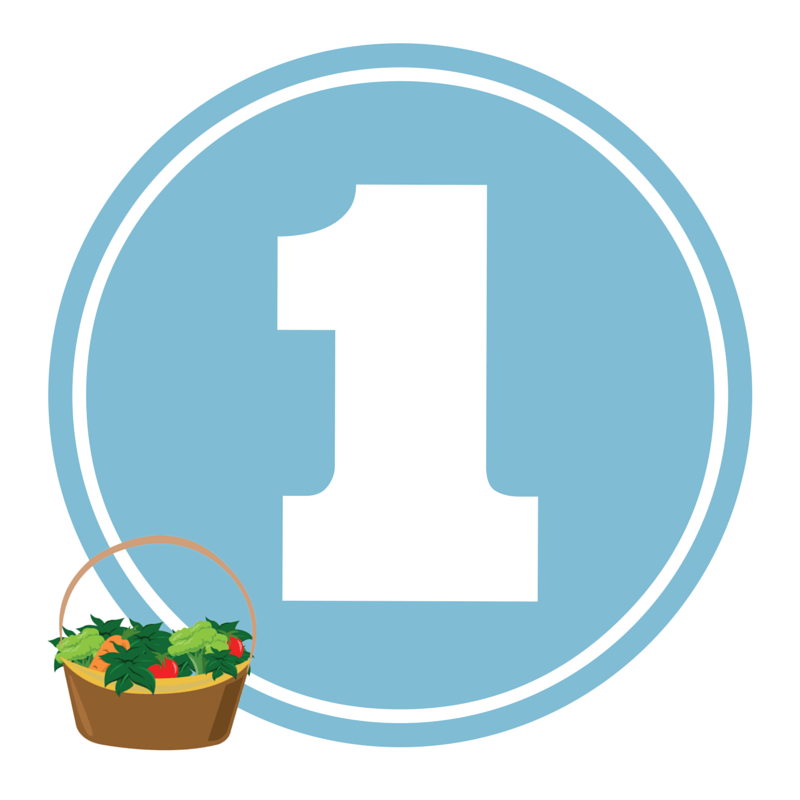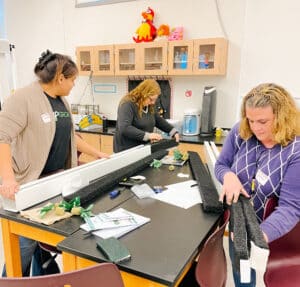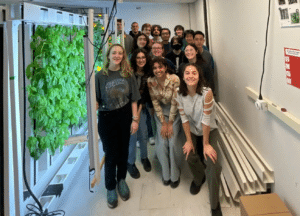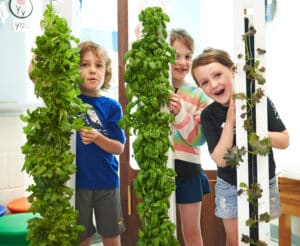Finding Funding for Soil-Less Science
Last week I attended the School Nutrition Association Conference in Casper, WY where I met tons of educators who were excited about the possibility of implementing soil-less science into their school. One educator already had a Spring System in her classroom, but really wanted to expand the project so that every room in the school had one. Another educator was thrilled about the idea of being able to grow fresh produce in ZipGrow Towers to service the cafeteria while providing new teaching opportunities as a school farm. Others said they would be happy to even have just one Vertical Garden Kit for their classroom.
Unsurprisingly, the biggest barrier and/or concern for these educators was funding, and you may find yourself in the same boat.
Let’s be realistic – most schools don’t have a big enough budget to allow every educator to implement a new classroom garden into their school. This can be discouraging. But don’t let it stop you. Here at Bright Agrotech, we are constantly searching for new funding opportunities for our educators.
There are tons of funding options out there which plenty of educators have successfully used to implement a ZipGrow soil-less science classroom garden into their school. Today, I’m going to fill you in on the top 10 state and national funding opportunities for soil-less science educators as provided to me by Brook Brockman, the Grants Coordinator for the Wyoming Department of Education.
*Please note that some of these funding opportunities may be approaching this year’s deadlines or have already expired. However, next year’s applications and openings are expected to be released soon.
Special Update 2/5/2016
I have a new grant opportunitiy for you all! And best yet – there’s no deadline!
“Project Produce – Fruit and Veggie Grants for Schools— The Chef Ann Foundation has teamed up with Skoop, a superfoods company committed to bringing the health benefits of superfoods to every American. Together we have launched Project Produce: Fruit and Veggie Grants for Schools. These $2,500 grants assist you in expanding your students’ palates, and encouraging increased consumption of and exposure to fresh produce through engagement in lunchroom education activities that encourage students to taste new vegetables and fruits offered either in a dish, cooked, or raw.”
 Specialty Crop Grants
Specialty Crop Grants
Specialty Crop Grants can be used to purchase things like hoop houses, a few Spring Systems or Classroom Packages, heating mats, and seed starting kits in order to grow a specialty crop. From there, the FFA program for example, can sell this produce for a profit.
Specialty crop grants have lots of variety and opportunity. Money is expected to continue to be available in this area especially after the last Farm Bill. Funding levels range from $500 to $3,500 and although this is a reimbursable grant which requires a 25 percent in-kind match, the match does not have to monetary; it can be in labor or other forms.
Difficulty: Easy
Level: State More information can be found here.
NRCS Conservation Innovation Grant
 NRCS Conservation Innovation Grants may be used to purchase and implement promising innovative technologies in your school which will work toward a goal of conservation and solving some of the more urgent natural resource issues in the Nation. A classroom could practice water conservation by using innovate ZipGrow technology in their school.
NRCS Conservation Innovation Grants may be used to purchase and implement promising innovative technologies in your school which will work toward a goal of conservation and solving some of the more urgent natural resource issues in the Nation. A classroom could practice water conservation by using innovate ZipGrow technology in their school.
Difficulty: Easy
Level: State and National
More information can be found here and here.
USDA Rural Developments Grant Programs
 USDA Rural Development Grant Programs can be used to purchase or fund materials, resources, equipment, training, etc. for use toward developing rural areas and communities. For example, if you are focusing on growing with sustainable energy, your grant could go toward the purchase of a solar water system for a vertical hydroponic school greenhouse with ZipGrow towers. Or, if your school needs an improved kitchen, a Community Facilities Direct Loan & Grant Program could help you purchase equipment like ZipGrow towers to grow produce for your school kitchen.
USDA Rural Development Grant Programs can be used to purchase or fund materials, resources, equipment, training, etc. for use toward developing rural areas and communities. For example, if you are focusing on growing with sustainable energy, your grant could go toward the purchase of a solar water system for a vertical hydroponic school greenhouse with ZipGrow towers. Or, if your school needs an improved kitchen, a Community Facilities Direct Loan & Grant Program could help you purchase equipment like ZipGrow towers to grow produce for your school kitchen.
Rural Development grants are nice because they are more broad and applicable to larger project. The one pitfall is that your school (or organization) must be located in a rural town that has a population of 20,000 or less.
Funding Amounts: Varies
Difficulty: Varies Level: More national, but through state rural development
You can find more information here and here.
Farm to School Grants
 Farm to School grants have a wide variety of uses from training and implementation funding to actual project equipment funding. The four specific categories are Support Service Grants, Implementation Grants, Planning Grants, and Training Grants. Read about Jay Super’s Hydroponic Hallway to see an example of how a Farm to School grant can be used.
Farm to School grants have a wide variety of uses from training and implementation funding to actual project equipment funding. The four specific categories are Support Service Grants, Implementation Grants, Planning Grants, and Training Grants. Read about Jay Super’s Hydroponic Hallway to see an example of how a Farm to School grant can be used.
Farm to School grants are great because there is a lot of backing behind it, there are tons of resources out there about it, and you can get some serious funding from it – up to $100,000. Just keep in mind, these grants have fairly strict requirements and you must match your funding amount by 25 percent.
Difficulty: Medium to Hard
Level: State and National
For more information on the national program go here. To learn about Farm to School on a state level, visit this website.
Team Nutrition Grants
 These grants [p]rovide training and technical assistance to school nutrition food service professionals to enable them to prepare and serve nutritious meals that appeal to students[, p]rovide fun and interactive nutrition education for children, teachers, parents and others caregivers [and build] school and community support for creating healthy school environments that are conducive to healthy eating and physical activity. The biggest push in this particular area is to get classroom gardens into childcare centers, so if you are in a childcare center, this one is a great option!
These grants [p]rovide training and technical assistance to school nutrition food service professionals to enable them to prepare and serve nutritious meals that appeal to students[, p]rovide fun and interactive nutrition education for children, teachers, parents and others caregivers [and build] school and community support for creating healthy school environments that are conducive to healthy eating and physical activity. The biggest push in this particular area is to get classroom gardens into childcare centers, so if you are in a childcare center, this one is a great option!
There is quite a bit of money available for this grant, and the funding amounts can reach up to $350,000 if awarded to the state. Team Nutrition grants are provided to educators through their state agency after the agency applies for it and is accepted.
Difficulty: Varies
Level: National, but you are awarded it through your state
Check out the USDA‘s applicaton page for general information about this grant, but for information regarding your school and how to apply, contact your local grants coordinator through your state’s Department of Education.
Big-Box Store Foundation Grants (Lowes, Home Depot, Walmart, Shopko, etc.)
 One great classroom funding option educators don’t often know about are “Big-Box” store foundation grants. Some “Big-Box” stores are Lowe’s, Home Depot, Shopko and Walmart. These stores, and many more, have foundations established which provide grants and other opportunities for people to better their communities – commonly through school programs.
One great classroom funding option educators don’t often know about are “Big-Box” store foundation grants. Some “Big-Box” stores are Lowe’s, Home Depot, Shopko and Walmart. These stores, and many more, have foundations established which provide grants and other opportunities for people to better their communities – commonly through school programs.
These grants are typically for around $5,000 and can be used to purchase supplies, equipment and materials for classroom gardens, school farms, community projects, etc. They are easy, flexible, and fun!
Difficulty: Easy Level: State and National
Click the links above to visit each store’s foundation website.
USDA Healthier School Programs
 The USDA (and other initiatives) have launched many Healthier School programs in recent years. Programs like Let’s Move, Fuel Up to Play 60, Action for Healthy Kids, the Active School Acceleration Project and the Healthier US Schools Challenge provide new opportunities and funding for schools looking to provide better access to good nutrition and physical activity to their students.
The USDA (and other initiatives) have launched many Healthier School programs in recent years. Programs like Let’s Move, Fuel Up to Play 60, Action for Healthy Kids, the Active School Acceleration Project and the Healthier US Schools Challenge provide new opportunities and funding for schools looking to provide better access to good nutrition and physical activity to their students.
These programs are pretty flexible and are very fun to implement (not to mention they have a lot of support from parents).
With funding from these competitive programs, you can purchase ZipGrow systems and other necessary equipment or structures to start a classroom garden or school farm. Vertical hydroponic gardening not only provides students with healthier, tastier, and more fresh produce, it also gives them a way to learn while moving their bodies and staying active.
Funding amount: Varies
Difficulty: Easy to Medium Level: National
Check out the links above for funding opportunities in each program.
Funding From Local Economic Development Boards
 Although there may not always be funding provided in this area, chances are your local Economic Development Board has money available to support community projects – including school farms or gardens. Funding will vary and you will likely have to write up a proposal, but this may be a more direct option for some schools. In addition, it is more possible to make the community aware of your project and gain stronger support.
Although there may not always be funding provided in this area, chances are your local Economic Development Board has money available to support community projects – including school farms or gardens. Funding will vary and you will likely have to write up a proposal, but this may be a more direct option for some schools. In addition, it is more possible to make the community aware of your project and gain stronger support.
Try making a proposal for funding for a school farm in which students have the opportunity to harvest and sell their produce at the Farmers’ Market or in a school-wide CSA. A program like this has the potential to give students practical business experience, pump more financial activity into the local economy, and create more locally available, healthy food.
Difficulty: Moderate Level: Local
Contact your local Economic Development Board for more information on applying for funds.
Training and Education Conference Funding
 One of the first steps in getting funding for your classroom garden or farm is to understand how to apply for and manage your grants applications. Since some of the aforementioned grants can have rather complicated applications, states frequently hold conferences and training sessions on how to apply for and use these grants. As it happens, there’s is even funding for this! For example, after applying for a scholarship, I was able to attend the recent SNA Conference free of charge, where I learned more information about Farm to School and had ample networking opportunities.
One of the first steps in getting funding for your classroom garden or farm is to understand how to apply for and manage your grants applications. Since some of the aforementioned grants can have rather complicated applications, states frequently hold conferences and training sessions on how to apply for and use these grants. As it happens, there’s is even funding for this! For example, after applying for a scholarship, I was able to attend the recent SNA Conference free of charge, where I learned more information about Farm to School and had ample networking opportunities.
Many training and education conferences on everything from how to apply for and use specific grants, to how to implement and teach new government-backed concepts are available and should definitely be taken advantage of. These will help you be more successful in your efforts to get funding and keep your funding.
To learn what training sessions and conferences are available and offer funding or scholarship programs, contact your states’ Department of Education or do a quick google search!
Grants.gov
 If none of the funding opportunities above work for your situation, or if you are just interested in doing some more research, check out grants.gov. Grants.gov lets you search through massive amounts of available grants and loan programs online.
If none of the funding opportunities above work for your situation, or if you are just interested in doing some more research, check out grants.gov. Grants.gov lets you search through massive amounts of available grants and loan programs online.
You can also view basic information on grants in general and do an advanced search to narrow down your options. It’s your one-stop-shop for grants, but it can be a little overwhelming.
Just remember – Funding your classroom garden is easier than you think! Educators have had no problem finding funding through school budgets, Farm to School programs, national and local grants, fundraising/community initiatives and donations. Now that you have seen the top 10 funding opportunities for soil-less science educators, go apply!
And don’t forget, we offer our products at a special discounted rate for educators!
You can ask me about this by emailing [email protected].






